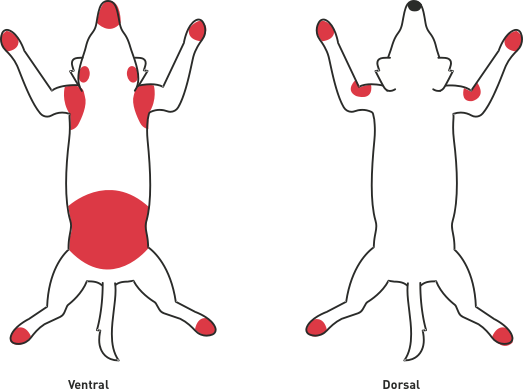Atopic dermatitis in dogs: more than a scratchy disease
If your dog’s skin shows signs of redness, they’re biting the end of their limbs or scratching more than usual, you might wonder what’s going on. And if you’ve made sure their flea treatment is up to date and you’ve checked them all over for parasites,but found nothing, then you could be left scratching your head too! Possibly your dog is suffering from an allergy, more precisely, from Canine Atopic Dermatitis aka CAD. Let’s have a look at this condition and how you can recognise it, but remember, no one does this better than your vet!
Article

What is canine atopic dermatitis?
CAD is one of many allergic conditions in dogs. Put simply, it’s called "Canine" for dog, "Atopic" for allergic trend which express by certain skin signs and "Dermatitis" because it causes irritated skin. Put scientifically, it’s a genetically predisposed inflammatory and pruritic skin disease found in up to 10% of dogsandsome breeds are more prone to it than others. And put in other words, it's “environmental atopy” or atopy.
Atopic dogs have a fragile skin barrier that can’t protect them properly, allowing airborne allergens to pass and trigger a defensive reaction from their immune system, leading to inflammation, and itchiness. These allergens can be found...Well, everywhere -In your home, garden or on the path of your dog’s favourite walk and they may come from grass, dust mites, pollen, or mould. Finding the one your dog is allergic to will often require you and your vet to put on your Sherlock Holmes’ hats!
The clues to help recognise canine atopic dermatitis
First, you might observe behavioural changes such as frequent:
- Scratching
- Licking and chewing
- Rubbing
- Violent head shaking
These useful clues run only skin-deep. In fact, they sometimes hide other symptoms of ear or skin infections.
Looking closer, you may also notice:
- Redness
- Darker spots on the skin
- Scales or flakes
- Hair loss
- Greasy skin
- Yeasty smell
- Lesions in specific areassuch as inflamed skin on the belly, reddened skin & brown hairs in between the fingers...
This diagram will help you identify the areas where Canine Atopic Dermatitis lesionscan often be found.
- Paws
- Armpit
- Internal part of the joints(such as such as in the elbow fold)
- Tummy
- Face (Around the nose and near the ears)

Another clue is your dog’s age as Canine Atopy usually first appears when a dog is between one and three years old.
Although these clues are useful to assess the situation, only consulting a vet can lead to a diagnosis. It’s only once the other possible causes or conditions with similar clinical signs have been discounted, that the CAD diagnosis can start. To rule them out, your vet will go through your pet’s history, their symptoms, a dermatological exam, and eventually an 8 to 12 week elimination diet to ensure your dog is not suffering from a food allergy (the signs can be quite similar). Once the diagnosis of Canine Atopic Dermatitis is confirmed, your vet may propose to perform some specific allergy testing to identify the triggering allergens and then start desensitization if this is relevant for your pet.
How can nutrition be beneficial to prevent and manage canine atopic dermatitis?
Although CAD requires lifelong attention, it can be managed on a daily base by making simple but important choices. It’s well known that atopic skin needs a lot of care. Your veterinarian will define with you the best management plan, which may include combination of pills, shampoos or creams, and adapted food for instance. The goal being to strengthen the skin barrier, help decrease inflammation, support your dog overall skin & coat health, scratching much less and feeling better! Calming lotions and sprays, or some pills can also soothe the pain and relieve your pet. What is less well known however, is that their skin can also be fed, hydrated, and healed from the inside.
Special food enriched with good sources of essential fatty acids from the omega 3 & 6 families, helps calm and protect your dog’s skin and make it less sensitive to irritation while helping their coat to stay full and healthy. Rich in carefully selected and high-quality proteins and nutrients, this type of food may also support a good digestive tolerance while supporting the skin natural defences (against oxidation for instance) and providing key support for dogs prone to CAD and skin sensitivity in general.
To help support your dog’s skin health and assist in the recovery, your vet may also recommend a specific diet. Make sure you stick to it and avoid feeding your dog with food scraps or other treats (unless considered ok by your vet) which can jeopardise your pet’s healing process. Trust that your vet will know the best atopic dermatitis dogs treatment for your pet and always keep them in the loop if any new symptoms arise.
What’s next?
We’ve only scratched the surface and Canine Atopic Dermatitis might not be the reason your dog keeps scratching. It could be due to another skin condition, or it could be the symptom of something else with implications ranging from benign to life-threatening, so it’s important to never overlook the symptoms and always check with the vet!
Like & share this page with your friends & family